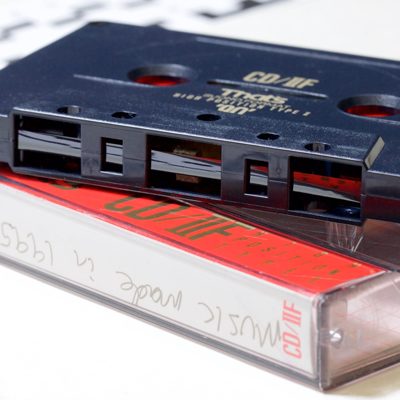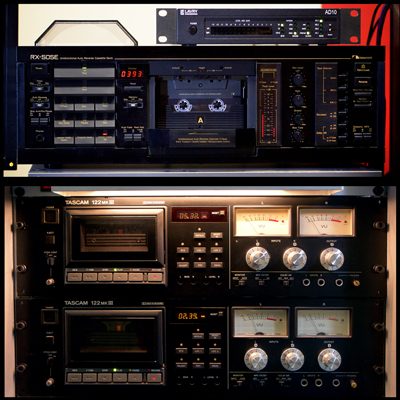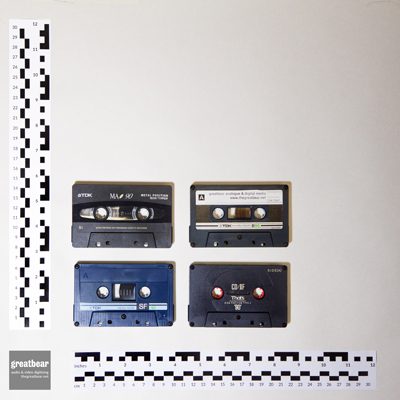introduction to compact cassette audio tape transfer
Developed by Philips in the early 1960s, by the 1980s this easy-to-use, highly portable format had become hugely popular for recording a vast range of audio projects. At Greatbear, we carefully restore and digitise all variations of compact cassette audio tape.
We can faithfully play back all speeds of recording, and decode Dolby B, Dolby C, Dolby S, and dbx Type II noise reduction standards.
See also our dedicated page for multitrack compact cassette recordings.
We offer a range of delivery formats for our audio transfers. Following International Association of Sound and Audiovisual Archives TC-04 guidelines, we deliver 24-bit / 96 kHz high resolution Broadcast WAV files, together with MP3 audio file or audio CD listening versions. We're happy to create any other digital audio files, according to your needs. We can also digitise to 24-bit / 192 kHz, if required.
We can provide the appropriately-sized USB delivery media for your files, or use media supplied by you, or deliver your files online. Files delivered on hard drive can be for any operating system - MacOS, Windows or GNU/Linux and filesystems (HFS+, NTFS or EXT3).
Compact cassette recordings vary both in duration and in the extent of physical tape degradation, so we always assess tapes before confirming the price of a transfer.
We offer free assessments - please contact us to discuss your project.
For an introduction to our assessment and treatment processes, please see our guide to "what happens to your audio tape".
compact cassette machines
While audio compact cassettes were an extremely common format for many years both domestically and professionally, not all cassette decks were made equal. We have collected and restored a range of machines that can give the highest quality replay and offer the most flexibility for problem tapes. Issues such as tape handling, speed stability, low wow and flutter and ease of azimuth adjustment are important factors in choosing appropriate replay machines.
To help with this we use Tascam 122 MkIII, Nakamichi RX505 and 680 and 600 series 3 head cassette decks when we digitise stereo audio cassettes and Teac C-3x and Tascam 234 and 238 decks for high speed 2 channel, 4 and 8 channel transfers. These machines all have their transports regularly cleaned and demagnetised and are serviced and checked using test equipment such as the Nakamichi T100 Audio Analyser and Lindos LA101 / 102 test equipment.
For very large scale jobs, we can parallel ingest in batches of 8 or 16 using our racks of Tascam decks.
compact cassette format variation
| track format | tape speed (ips) | noise reduction | supported |
|---|---|---|---|
| twin track stereo | 15⁄16 | no noise reduction | ✓ |
| Dolby B | ✓ | ||
| Dolby C | ✓ | ||
| Dolby S | ✓ | ||
| dbx Type II | ✓ | ||
| twin track stereo | 1 7⁄8 | no noise reduction | ✓ |
| Dolby B | ✓ | ||
| Dolby C | ✓ | ||
| Dolby S | ✓ | ||
| dbx Type II | ✓ | ||
| twin track stereo | 3 ¾ | no noise reduction | ✓ |
| Dolby B | ✓ | ||
| Dolby C | ✓ | ||
| Dolby S | ✓ | ||
| dbx Type II | ✓ |
compact cassette tape risks & vulnerabilities
Sometimes, compact cassettes have physical problems that need to be addressed and repaired before a good transfer can be made. These can be:
- respooling loose or damaged tape in the existing cassette shell
- splicing or refixing the leader tape to a reel hub
- reshelling the tape in a new cassette shell
- baking sticky tape
- addressing fungal growth on tapes stored in less than ideal environments
Due to their small tape width and slow recording speed, compact cassettes have a reputation for poor sound quality and reduced frequency response. This is often the case but, with the right tools, well-recorded cassettes can sound very good and the best can be got from these recordings.
It’s quite common for the Azimuth in cassette recordings to vary between tapes and recording machines. Unless you are playing back a tape recorded from a known, properly-calibrated tape machine it is often necessary to adjust the playhead azimuth to get the best high frequency response when digitising audio cassettes. On many cheap tape players this is difficult, not very accurate and is often not done, so tape transfers can suffer. The machines we use all have easily-adjusted playhead azimuth to get the best from your tapes.
compact cassette recording history
In 1962 Lou Ottens' team at Philips invented a revolutionary medium for audio storage. It was introduced in Europe in August 1963 and in the United States in November 1964, with the trademark name Compact Cassette.
Compact cassette tape is 3.81 mm (0.150 in) wide, with each stereo track 0.6 mm wide and an unrecorded guard band between each track. At standard speed, the tape moves at 4.76 cm per second (1⅞ inches per second) from left to right.
In the early years, sound quality was mediocre, but it improved dramatically by the early 1970s when it caught up with the quality of 8-track tape and kept improving. The compact cassette went on to become a popular (and re-recordable) alternative to the 12-inch vinyl LP during the late 1970s.
For a time in the 1970s and 1980s the cassette was a ubiquitous part of everyday life. The invention of the Walkman in 1979 revolutionised how and where people listened to music. The compact cassette’s modest size allowed recorded music to be personal and portable. The cassette was used in many different contexts, from car stereos and police stations – making it one of the most flexible and widely used recorded formats in history.





